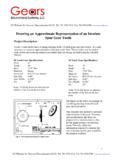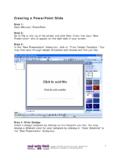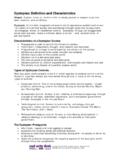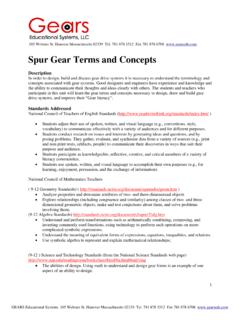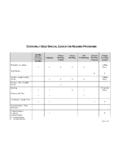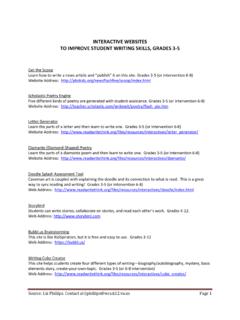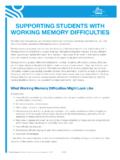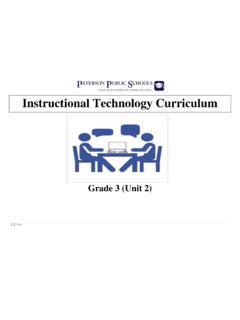Transcription of 105 Webster St. Hanover Massachusetts 02339 Tel. 781 878 ...
1 105 webster st . Hanover Massachusetts 02339 Tel. 781 878 1512 Fax 781 878 6708 Battery Basics Research, Test, Measure,Analyze, and Select the Optimal Battery C. A. P. A. C. I. T. Y. GEARS EDUCATIONAL SYSTEMS 105 webster st . Hanover Massachusetts 02339 Tel. 781 878 1512 1. Fax 781 878 6708 copyright 2009. Battery Basics Terms These are essential terms used when discussing and describing batteries and battery performance. Review these terms at the beginning of the lesson. Amp Hour Current Draw Lithium-ion Ampere Constraints Lithium-polymer Anode Cycle Life Nominal Voltage Battery Deep Discharge Open Circuit Voltage Battery Packs Discharging Ohms Battery Capacity Energy Overcharging Cathode Energy Density Primary Cell Cell Internal Resistance Resistance Charging Watt hours Secondary Cell Closed Circuit Voltage Nickel Cadmium Voltage Current Nickel Metal Hydride Watts Milliamp-hour Tools/Materials Battery Test Circuit Face Shields/Goggles Recording Sheets Volt Meter Spare bulbs Comfortable Chair Ammeter (10 amp+ rating) Stop Watch Chalk/white board Bulb Socket Pencils Supervisory Adult Test Leads (2 pair) Suitable Battery Charger Objectives Students and teachers who participate in the instructional activities described in this lesson will: 1.
2 Use meters to measure amperes (current) and voltage of a circuit through which a battery is being discharged. 2. Perform tests to record data used to determine the actual capacity of a battery under a specific load. 3. Source and read battery manufacturer's specification sheets and compare them to the results of their tests. 4. Use a spread sheet and graphs to analyze the performance of the batteries being tested. 5. Develop the skills and techniques necessary to determine the performance of any available battery. 6. Calculate the energy density of a battery given the manufacturer's specifications and/or battery test results. 7. Match battery performance and specifications to specific project requirements. 8. Apply their understanding of battery performance to create mathematical models in order to determine the suitability of a battery for a given current and voltage application.
3 GEARS EDUCATIONAL SYSTEMS 105 webster st . Hanover Massachusetts 02339 Tel. 781 878 1512 2. Fax 781 878 6708 copyright 2009. Topics to Review Before You Start These Units Basic electrical units: (Amperes and Current) (Voltage and Electromotive Force, EMF) and (Ohms and resistance). Solve algebraic expressions with a single variable. Example: Using Ohm's Law, review methods for solving this equation for each and every variable. E = I*R I = E/R R = E/I. Each of these expressions describes the relationship between Current (I), Voltage (E) and Resistance (R ) in an electrical circuit. How Ohm's law is used to determine the current, voltage or resistance in an electrical circuit when any two of the variables are given as well as the algebraic statement that describes Ohm's Law How to measure volts, amperes and resistance with a Multimeter.
4 The meaning and use of scientific prefixes such as micro, milli, kilo and mega. GEARS EDUCATIONAL SYSTEMS 105 webster st . Hanover Massachusetts 02339 Tel. 781 878 1512 3. Fax 781 878 6708 copyright 2009. Standards Addressed in These Lessons National Council of Teachers of English Standards ( ). Students adjust their use of spoken, written, and visual language ( , conventions, style, vocabulary) to communicate effectively with a variety of audiences and for different purposes. Students conduct research on issues and interests by generating ideas and questions, and by posing problems. They gather, evaluate, and synthesize data from a variety of sources ( , print and non-print texts, artifacts, people) to communicate their discoveries in ways that suit their purpose and audience. Students use spoken, written, and visual language to accomplish their own purposes ( , for learning, enjoyment, persuasion, and the exchange of information).
5 (9-12 ) Science and Technology Standards (from the National Science Standards web page). #unifying Unifying concepts and process standard Conceptual and procedural schemes unify science disciplines and provide students with powerful ideas to help them understand the natural world. Unifying concepts and processes include: Systems, order and organization (Batteries are components that can be modeled mathematically using a basic understanding of physical science concepts that include Resistance, Amperage, Voltage and Watts). Evidence, models and organization (Graphing battery data and making mathematical predictions based on that data, and comparing the results to actual tests can help solidify understanding how to choose and use different batteries for differing applications). Change, constancy and measurement (Battery capacity and energy density are dependent on the battery chemistry, weight and volume.)
6 Form and function (Understanding that battery capacity and performance depend on chemistry, size, weight and discharge conditions is necessary to make informed battery engineering and purchasing decisions). Motion and Forces Voltage is the force that moves current through a given resistance. By testing and evaluating the capacity and performance of batteries, students and teachers will become more familiar with abstract science concepts like voltage, current and resistance, as well as energy and power. Interactions of Energy and Matter Batteries are electro chemical devices. The nature of the chemistries employed in the manufacture of the battery effect the capacity and performance of the batteries. Some examples of battery cell chemistries and voltage are provided below: GEARS EDUCATIONAL SYSTEMS 105 webster st . Hanover Massachusetts 02339 Tel.
7 781 878 1512 4. Fax 781 878 6708 copyright 2009. Description The battery pack is one of the defining aspects of any portable or mobile electronic project. Since the battery pack affects the weight, range, operating time and cost of the project it is essential that a designer or engineer be capable of selecting an optimal battery strategy for a particular application. The following outline suggests one possible method for selecting an optimal battery pack for a given application: 1. Determine the necessary voltage(s). 2. Calculate the minimum current requirements for the given application with respect to current requirements to support the operating time and/or range. 3. Determine the minimum battery capacity. 4. Determine the appropriate physical requirements. (Size and weight). 5. Consider chemistry, cost, connections, charging requirements 6.
8 Research vendors and select battery packs The Battery Basics lesson is designed to provide students with an opportunity to develop a working understanding of battery technology and use that understanding to properly design or acquire battery packs that are appropriate for a given application. Participating students will source and read manufacturer's specifications as well as test, measure and create mathematical models to describe and select optimal battery packs given the voltage, current capacities and energy requirements for a particular application. The knowledge and skills described in this lesson will be used to solve real world engineering problems that require students to analyze a particular battery application and make an informed decision concerning the selection of an optimal battery voltage, capacity chemistry, form factor and charging system necessary to successfully meet the constraints imposed by that application.
9 Battery Basics Batteries are energy storage devices that are particularly useful for powering small portable devices like phones, laptops and entertainment devices as well as mobility devices that travel over the earth's surface, through water and in the air. Batteries used in these applications are engineered to meet the unique design constraints imposed by these different applications. These constraints include: Number of Cells or Voltage The term battery refers to a system of one or more cells. A cell represents a particular chemical combination capable of producing a voltage and current. Different chemical GEARS EDUCATIONAL SYSTEMS 105 webster st . Hanover Massachusetts 02339 Tel. 781 878 1512 5. Fax 781 878 6708 copyright 2009. combinations produce different voltages. By combining cells in series the voltage of a battery pack can be increased as a multiple of the number of cells x the voltage for each cell.
10 Caution: Do not integrate cells of different chemistries into the same battery pack. Activity: Using manufacturers literature or the internet to research available information about 2 of the 4 different battery cell chemistries. Find and record as much as you can about the two chemistries that you chose to research. Using what you learned, find two different vendors who can supply battery packs for each of the (2) battery chemistries you have researched. Record the cost and capacity of the battery packs you find. Create a presentation slide or report for each of the two chemistries and present your findings. Log your research and findings in your notebook Battery Chemistry A rechargeable battery is referred to as a storage battery and is usually constructed of one or more secondary cells. Each cell is capable of producing a specific voltage with respect to the electro-chemical make up of the cell.
